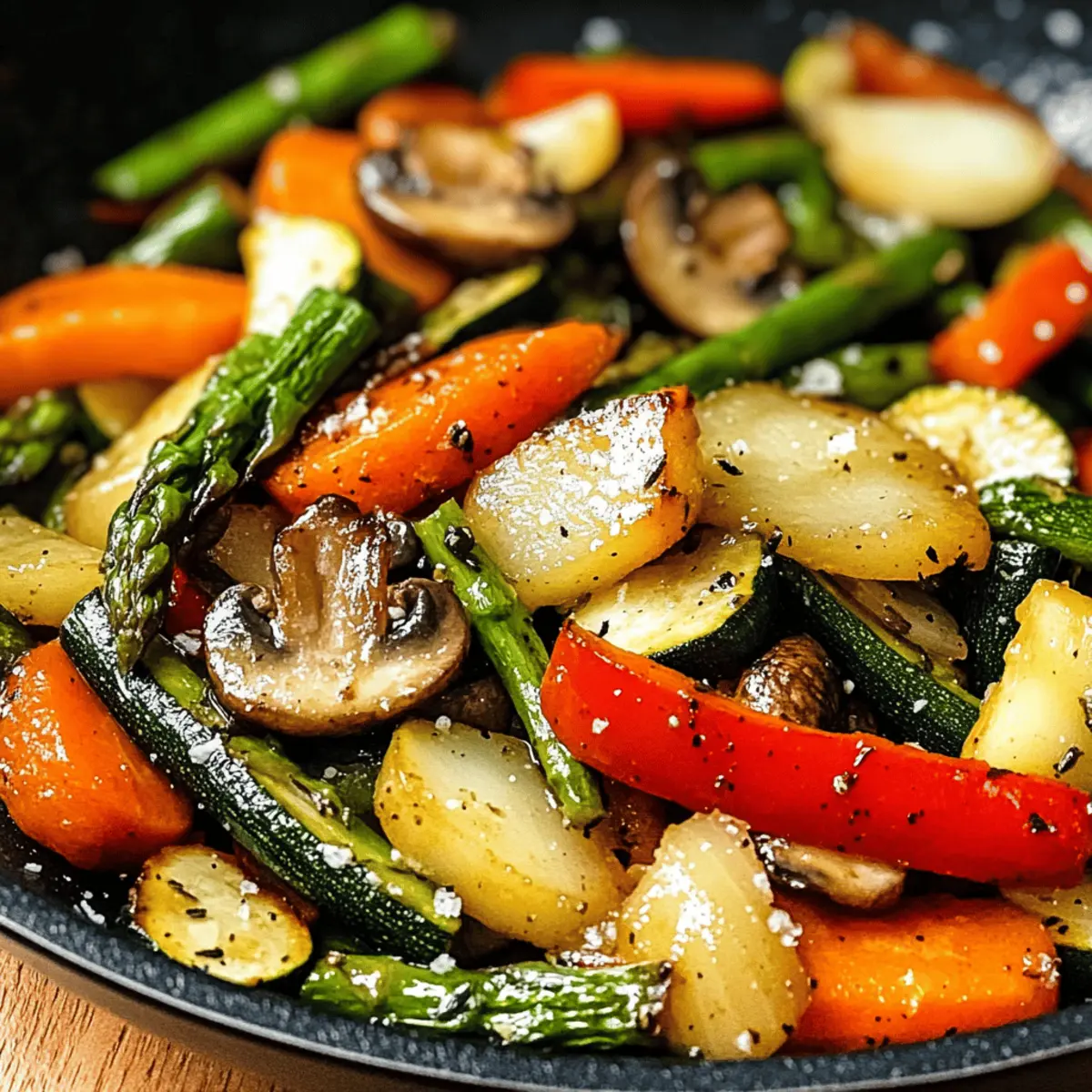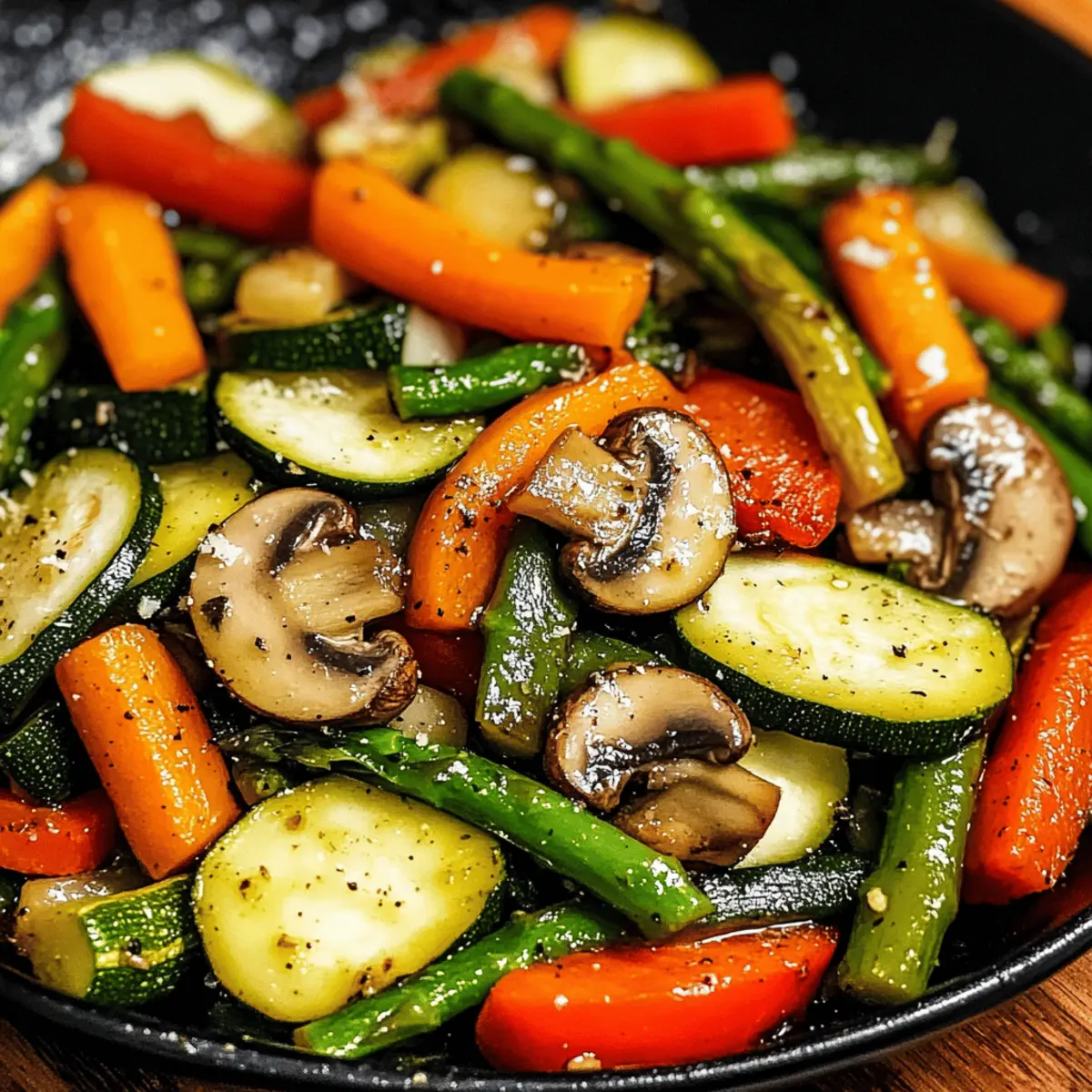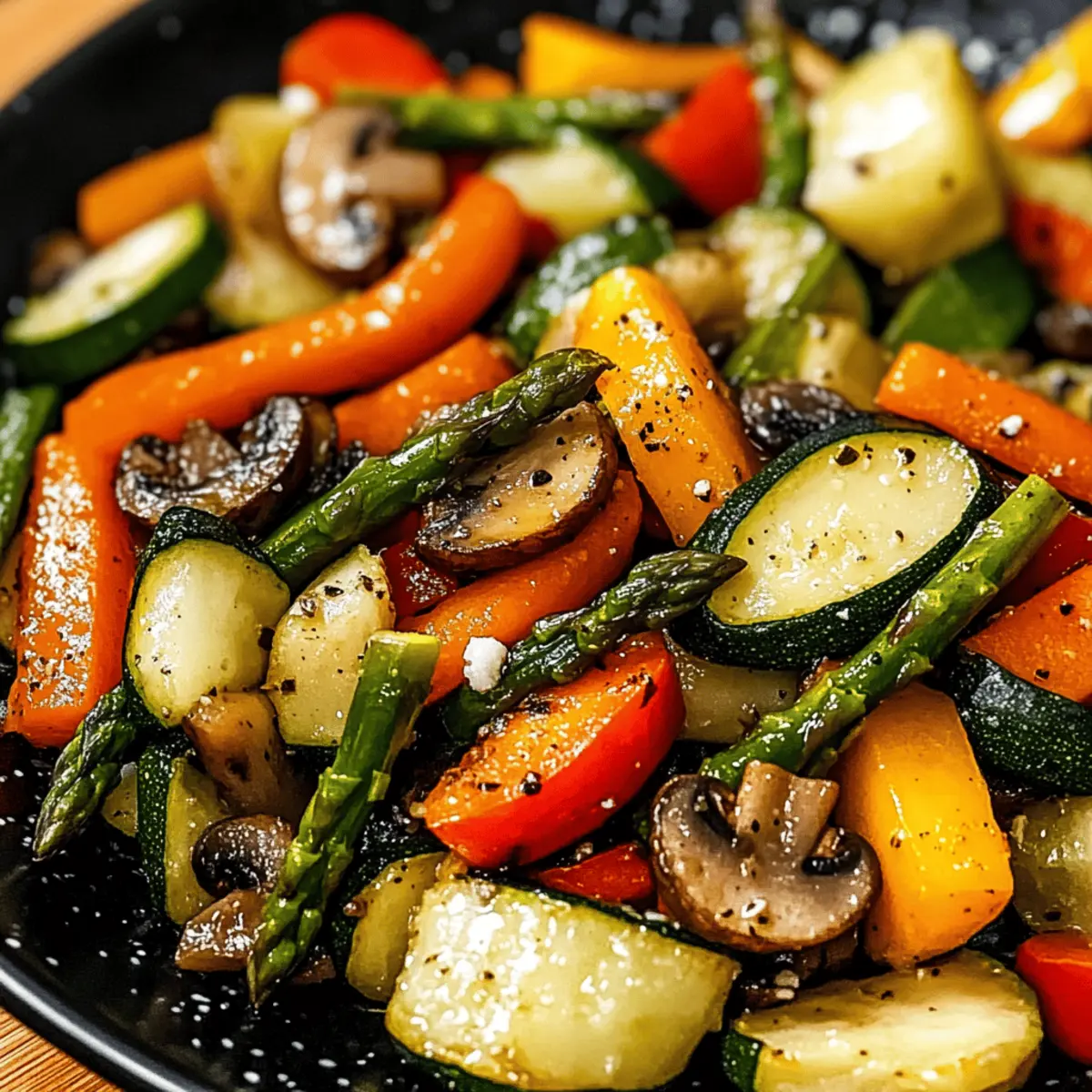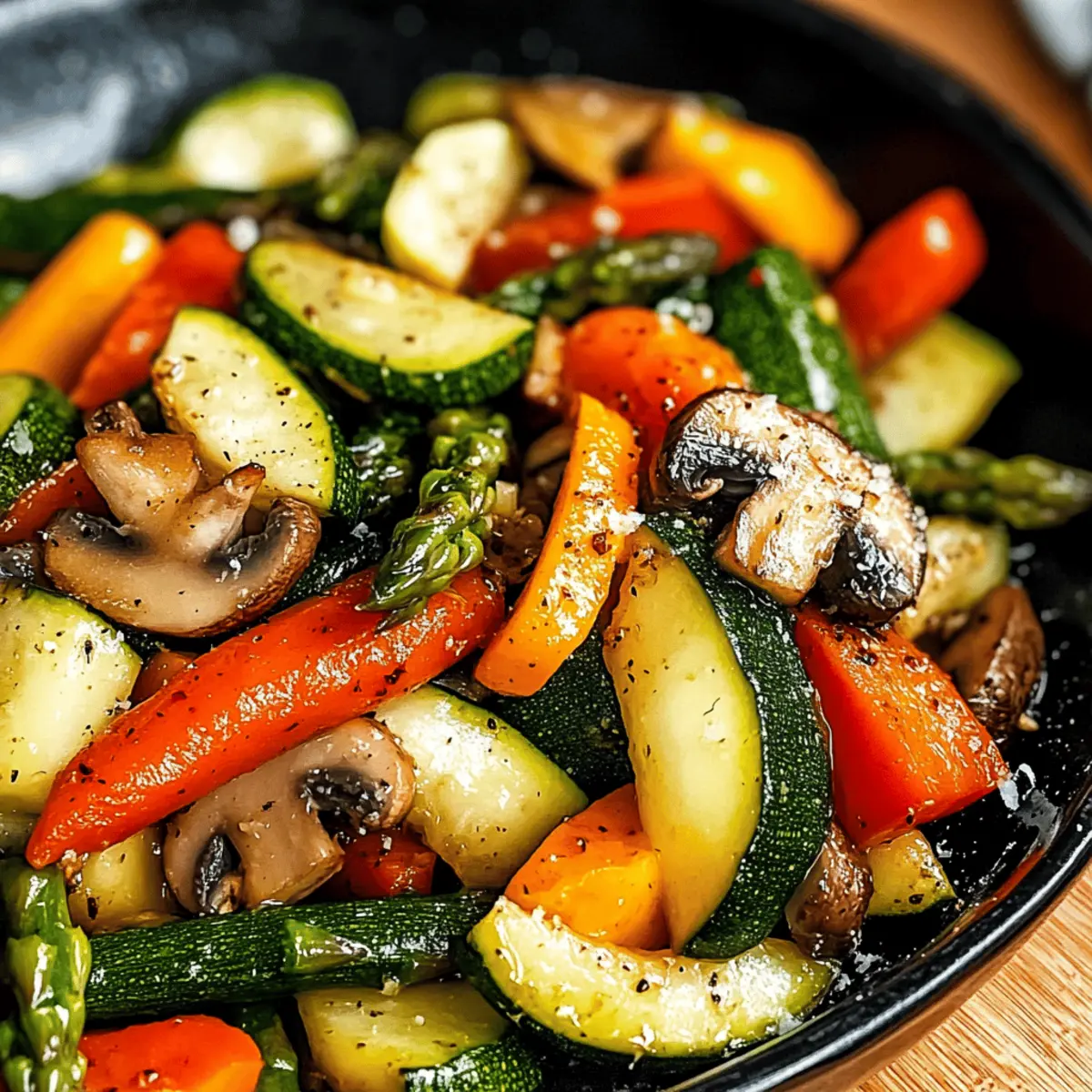As I tossed those vibrant veggies into the sizzling skillet, I couldn’t help but smile at how a medley of colors can brighten any weeknight dinner. These Healthy Sautéed Vegetables are my go-to side dish, proving that wholesome meals don’t have to be time-consuming. With just a few minutes of cooking, you create a nutrient-packed, delicious accompaniment to almost any main course. Plus, this recipe is incredibly versatile! You can adapt it based on what’s in your fridge or what’s in season, ensuring everyone can enjoy it their way. Who wouldn’t love a quick, easy, and healthy side that makes every plate pop with flavor? Ready to dive into this surprisingly simple yet satisfying dish? Let’s sauté!

Why are these sautéed vegetables a must-try?
Vibrant, Colorful Variety: Each bite is an explosion of hues that elevates your meal both visually and nutritionally.
Quick Cooking: You’ll have a delightful side ready in no time—perfect for busy weeknights!
Customizable Options: Use whatever seasonal veggies you have on hand and create your own unique combination. From adding kale to incorporating your favorite protein, the possibilities are endless!
Health Packed: With nutrient-rich ingredients in every bite, these vegetables are not only delicious but also perfect for maintaining a balanced diet. Pair them with Healthy Sauteed Vegetables to boost your fiber intake.
Satisfying Texture: Enjoy the perfect balance of crispiness and tenderness, making each mouthful a flavorful experience.
Healthy Sautéed Vegetables Ingredients
For the Vegetables
• Garlic – Adds aromatic flavor; substitute with garlic powder (start with ½ teaspoon).
• Carrots – Provide sweetness and crunch; cut into thin rounds for even cooking.
• Asparagus – Adds texture and earthy flavor; broccoli or cauliflower can be excellent alternatives.
• Red Bell Pepper – Adds sweetness and vibrant color; yellow or orange bell peppers work similarly.
• Zucchini – Contributes a tender, mild flavor; summer squash can be used in its place.
• Mushrooms – Offer a savory umami component; assorted mushrooms or omit them for a vegetarian version.
• Green Onions – Enhance flavor with mild onion notes; use both green and white parts for depth.
For Cooking
• Extra-Virgin Olive Oil – Essential for sautéing, adds richness; canola or grapeseed oil can be used for a neutral flavor.
For Topping
• Parmesan Cheese – Provides a savory finish; crumbled feta gives a tangy twist if preferred.
• Lemon Juice – Brightens flavors and adds acidity.
For Seasoning
• Sea Salt – Enhances all flavors in the dish.
• Black Pepper – Adds mild heat.
• Onion Powder – Contributes additional savory depth.
• Red Pepper Flakes – For a spice kick; adjust to taste.
• Italian Herb Blend – Adds a burst of herbal freshness.
• Smoked Paprika – Introduces a warm, smoky flavor that complements the vegetables beautifully.
These Healthy Sautéed Vegetables are not just a side dish but a vibrant addition to your meals, bursting with nutrients and easily adaptable to your taste!
Step‑by‑Step Instructions for Healthy Sauteed Vegetables
Step 1: Prepare the Vegetables
Start by washing and drying all your vegetables thoroughly, then slice them uniformly to ensure even cooking. Chop the garlic, carrots, asparagus, red bell pepper, zucchini, mushrooms, and green onions. Aim for bite-sized pieces: this helps to maximize flavor and makes the sautéed vegetables easier to eat.
Step 2: Heat the Oil
In a large skillet, pour in 2 tablespoons of extra-virgin olive oil and heat it over medium-high heat until it shimmers but does not smoke—about 1-2 minutes. This ensures a good sear while cooking your Healthy Sautéed Vegetables. Keep an eye on the oil as it heats, ready for the next ingredient!
Step 3: Sauté the Garlic
Add the chopped garlic to the hot oil and sauté for 30 seconds, stirring constantly until fragrant—be careful not to let it burn. The aroma will start to fill your kitchen, setting the stage for a delicious mix of flavors in your sautéed vegetables.
Step 4: Add Carrots
Next, stir in the carrot rounds and allow them to sauté for about 2-3 minutes. Look for them to soften slightly while still retaining some crunch. This initial step is crucial as the carrots take a bit longer to cook than the other vegetables.
Step 5: Incorporate Asparagus and Zucchini
After the carrots have softened, add the chopped asparagus and zucchini to the skillet. Stir these in and cook for another 3-5 minutes until they turn bright green and tender-crisp. You’ll notice the veggies softening while preserving their vibrant colors—a hallmark of healthy cooking!
Step 6: Add Bell Peppers and Mushrooms
Introduce the sliced bell peppers and mushrooms to the skillet next. Continue to sauté everything together for another 2-3 minutes until the peppers are vibrant and the mushrooms have released their juices. This adds depth and umami flavor to your Healthy Sautéed Vegetables.
Step 7: Season the Vegetables
Sprinkle in sea salt, black pepper, onion powder, red pepper flakes, Italian herb blend, and smoked paprika. Give it a stir for about 1 minute to allow the seasonings to coat the vegetables evenly. This layer of seasonings transforms your mixture into a flavorful celebration of veggies.
Step 8: Finish with Lemon Juice and Cheese
Remove the skillet from the heat and drizzle the sautéed vegetables with fresh lemon juice. Sprinkle with Parmesan cheese for a savory finish. Allow the warmth from the vegetables to slightly melt the cheese, giving you a perfectly creamy texture. Now, your Healthy Sautéed Vegetables are ready to be enjoyed!

Make Ahead Options
These Healthy Sautéed Vegetables are perfect for busy home cooks looking to save time during the week! You can wash, chop, and refrigerate your vegetable mix up to 24 hours in advance, ensuring they stay fresh and flavorful. If you’re planning ahead for a gathering, you can also sauté the vegetables and let them cool completely before storing them in an airtight container for up to 3 days in the fridge. To finish, simply reheat the sautéed veggies in a skillet over medium heat, adding a splash of lemon juice and a sprinkle of Parmesan cheese before serving to maintain that vibrant flavor and texture. Enjoy the ease of meal prep with these delicious Healthy Sautéed Vegetables!
How to Store and Freeze Healthy Sautéed Vegetables
Fridge: Keep your sautéed vegetables in an airtight container for up to 3 days. Make sure they’re cooled completely before sealing to retain their texture.
Freezer: For longer storage, freeze in portions using freezer-safe containers or bags. They’ll stay fresh for up to 3 months.
Reheating: To reheat, thaw overnight in the fridge, then gently warm in a skillet over medium heat, adding a splash of olive oil to revive flavor and texture.
Meal Prep: These Healthy Sautéed Vegetables can be made ahead of time, making weekday meals a breeze when you have delicious leftovers ready to go!
What to Serve with Quick and Easy Sautéed Vegetables
Elevate your meal with these delightful pairings that perfectly enhance the vibrant flavors and textures of your sautéed veggies.
- Grilled Chicken: Juicy and smoky, grilled chicken adds a hearty protein that balances the fresh crunch of your sautéed vegetables.
- Baked Salmon: With its rich flavor, salmon beautifully complements the dishes’ bright notes, creating a perfect harmony of taste.
- Quinoa Salad: Nutty, fluffy quinoa not only rounds out the meal but also adds a delightful texture contrast to your vibrant sautéed veggies.
- Creamy Mashed Potatoes: The comforting creaminess of mashed potatoes provides a cozy base, marrying perfectly with the crispness of your sautéed vegetables.
- Lentil Soup: A warm bowl of hearty lentil soup enhances the meal’s nutrient profile, making it both filling and satisfying alongside those healthy sautéed vegetables.
- Garlic Bread: Crisp, buttery garlic bread offers a delightful crunch and rich flavor that echoes the sautéed garlic, turning your dinner into a comforting feast.
- Chickpea Salad: Bright, zesty chickpea salad adds protein-packed satisfaction while its fresh herbs and lemon juice echo the sautéed mix’s zestiness.
- Crisp White Wine: A chilled glass of Sauvignon Blanc possesses zesty notes that elevate the dishes’ brightness, making your dining experience feel even more refreshing.
- Fruit Sorbet: For dessert, a light fruit sorbet provides a refreshing end to your meal, cleansing the palate with fruity sweetness after the savory bites.
Healthy Sautéed Vegetables Variations
Feel free to mix things up and tailor this recipe to your taste and pantry! With so many options, you can create a new version each time.
- Seasonal Swap: Use seasonal veggies like Brussels sprouts or kale for a fresh twist. Each season offers a new canvas of flavors!
- Protein Boost: Add pre-cooked chicken, shrimp, or tofu for a satisfying, complete meal. This addition transforms your veggies into a hearty delight!
- Dairy-Free: Omit cheese or substitute with nutritional yeast for a cheesy flavor without dairy. It’s an easy way to keep it plant-based!
- Extra Heat: Spice things up with a dash of sriracha or diced jalapeños for everyone who loves a kick. A little heat adds excitement to your dish!
- Herb Infusion: Fresh herbs like basil or cilantro can brighten your sautéed veggies. Toss them in at the end for a burst of freshness!
- Flavorful Marinades: Marinate your vegetables in soy sauce or balsamic vinegar before sautéing for an umami-rich flavor. This elevates the entire dish to new heights!
- Nutty Twist: Toss in a handful of toasted nuts, such as almonds or walnuts, for added crunch and richness. They introduce delightful texture and flavor!
- Umami Explosion: Incorporate sun-dried tomatoes or miso paste for an extra rich, savory note. These additions will transform the end result into something extraordinary.
For even more nutritious sides, consider pairing these sautéed vegetables with Healthy Sauteed Vegetables or enjoy alongside a dish of Light Healthy Broccoli for a complete meal bursting with color and flavor!
Expert Tips for Healthy Sautéed Vegetables
-
Uniform Cutting: Ensure all vegetables are cut to a similar size for even cooking. This prevents some veggies from becoming mushy while others remain raw.
-
High Heat: Maintain a medium-high heat while sautéing to achieve caramelization. This adds depth and flavor without overcooking your Healthy Sautéed Vegetables.
-
Season Last: Add seasonings towards the end of cooking to keep the flavors vibrant and fresh. Dusting them on at the right time prevents burning and enhances taste.
-
Customize Freely: Feel free to swap in any seasonal vegetables you have on hand. The more variety, the more nutrient-packed your dish becomes!
-
Cool Before Storing: Let your sautéed veggies cool completely before refrigerating. This helps retain their crispness, so they maintain their delicious texture when reheated.

Healthy Sautéed Vegetables Recipe FAQs
How do I know when my vegetables are ripe enough to sauté?
Absolutely! For optimal flavor and texture, choose vegetables that are bright, firm, and free of blemishes. Look for vibrant colors—like deep green zucchini or bright orange carrots. Overripe veggies might have dark spots or a soft texture, signaling it’s time to pass on those.
What’s the best way to store leftover sautéed vegetables?
To keep your Healthy Sautéed Vegetables fresh, store them in an airtight container in the fridge for up to 3 days. Make sure they’re completely cooled before sealing, as this retains their texture. When you’re ready to enjoy them, simply reheat in a skillet with a touch of olive oil to revive their flavors.
Can I freeze sautéed vegetables for later use?
Very much so! To freeze your sautéed vegetables, allow them to cool completely, then place them in freezer-safe bags or containers. They can be frozen for up to 3 months. When ready to eat, thaw overnight in the fridge and gently reheat in a pan over medium heat, adding a splash of olive oil to restore their delicious texture.
What should I do if my sautéed vegetables turn mushy?
No worries! If your veggies become mushy, it might mean they were overcooked or not cut uniformly. For future batches, ensure your vegetable pieces are roughly the same size for even cooking. Also, keep the heat on medium-high to allow for quick sautéing, which helps maintain a pleasing crunch.
Are there any dietary considerations to keep in mind with sautéed vegetables?
Definitely! While the Basic Healthy Sautéed Vegetables recipe is vegan and gluten-free, always check for allergies, particularly with added ingredients like Parmesan cheese or specific seasonings. If you have pets, avoid feeding them any seasoned vegetables, as some spices like onion powder can be harmful to them.

Vibrant Healthy Sautéed Vegetables for Quick Everyday Meals
Ingredients
Equipment
Method
- Wash and dry all vegetables, then slice them uniformly.
- Heat olive oil in a skillet over medium-high heat until shimmering.
- Add garlic and sauté for 30 seconds until fragrant.
- Stir in carrot rounds and sauté for 2-3 minutes.
- Add asparagus and zucchini, cooking for another 3-5 minutes.
- Introduce bell peppers and mushrooms; sauté for 2-3 minutes.
- Season with salt, pepper, onion powder, red pepper flakes, herbs, and paprika.
- Finish with lemon juice and Parmesan cheese before serving.

Leave a Reply